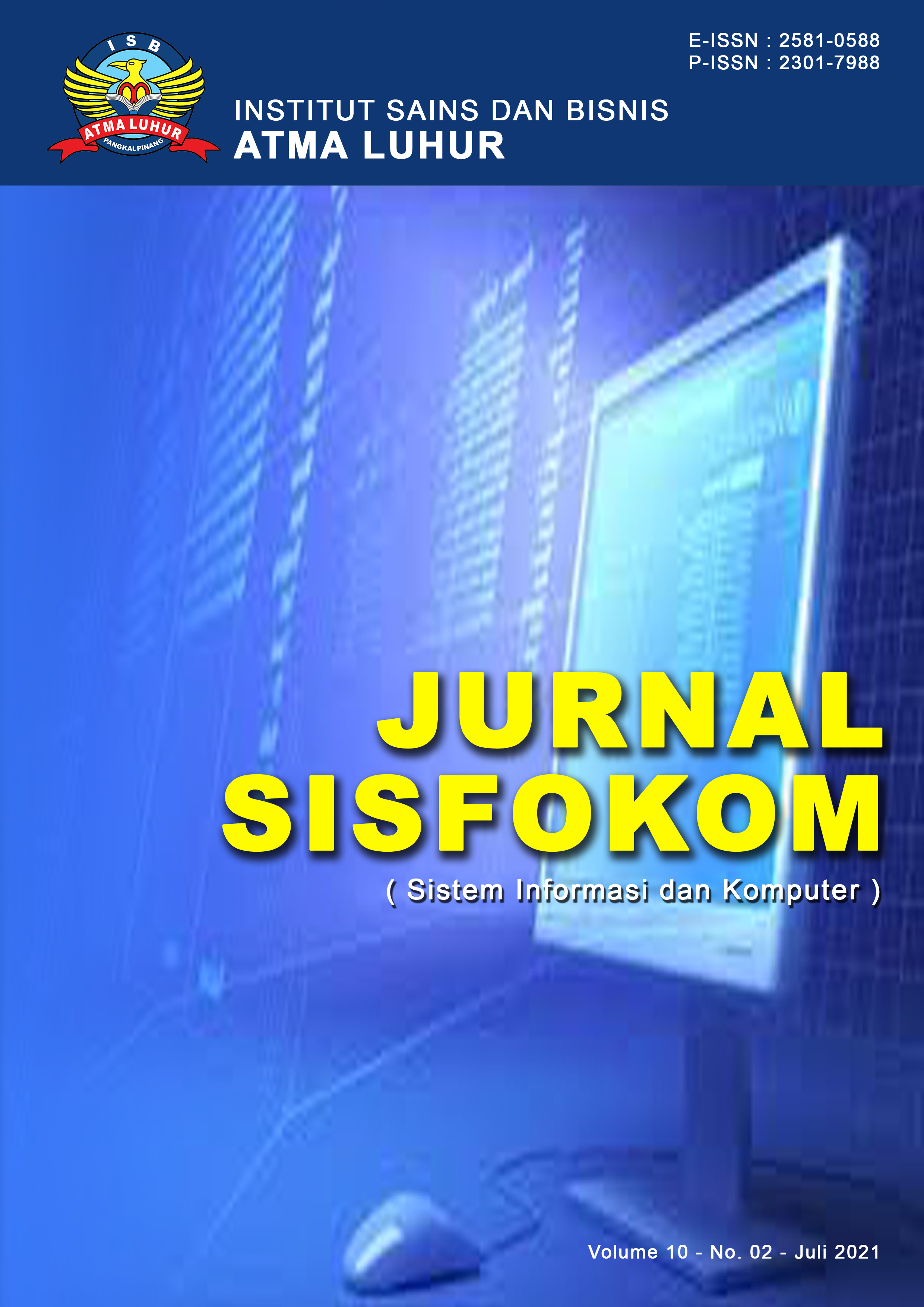Decision Support Systems In The Acceptance Of New Administrative Staff Using The SAW Method
DOI:
https://doi.org/10.32736/sisfokom.v10i2.1104Keywords:
Simple Additive Weighting, Academic Administration Staff, CriteriaAbstract
Abstract— Human resource is one very important factor in an organization or company, both public and private companies. The work success of a company is great has a major influence on the management of human resources (HR) of a company. If human resources are not good enough, it will affect the lack of good sustainability of this part of the company. Therefore, in the HR management of a company is very important, especially in accepting staff the best academic administration so that it can maximize performance. Many companies have difficulty in accepting candidates for academic administration staff accordingly to company desires. for that, a decision support system is needed that can help decision making to facilitate the acceptance of new academic administration staff. For that reason, researchers are very want to help top management in making the best decisions in recruiting new staff. This study uses the SAW (Simple Additive Weighting) method using the existing criteria determined by the company, namely administrative requirements, written tests, computer literacy, communication, and work experience. The results of the study are the value of calculating employee selection using the Simple Additive Weighting (SAW) method. to be able to help make decisions quickly, precisely, and accurately.References
S. Y. Chou, Y. H. Chang, and C. Y. Shen, “A fuzzy simple additive weighting system under group decision-making for facility location selection with objective/subjective attributes,” Eur. J. Oper. Res., vol. 189, no. 1, pp. 132–145, 2008, doi: 10.1016/j.ejor.2007.05.006.
T. Y. Chen, “Comparative analysis of SAW and TOPSIS based on interval-valued fuzzy sets: Discussions on score functions and weight constraints,” 2012, doi: 10.1016/j.eswa.2011.08.065.
W. Abrams et al., “Delineation of groundwater potential (GWP) in the northern United Arab Emirates and Oman using geospatial technologies in conjunction with Simple Additive Weight (SAW), Analytical Hierarchy Process (AHP), and Probabilistic Frequency Ratio (PFR) techniques,” J. Arid Environ., 2018, doi: 10.1016/j.jaridenv.2018.05.005.
M. Brandl and K. Kellner, “Position estimation of RFID based sensors using passive SAW compressive receivers,” 2014, doi: 10.1016/j.proeng.2014.11.415.
G. Büyüközkan and M. Güler, "Smartwatch evaluation with integrated hesitant fuzzy linguistic SAW-ARAS technique," Meas. J. Int. Meas. Confed., 2020, doi: 10.1016/j.measurement.2019.107353.
O. Rizan, “Penerapan Metode SAW ( Simple Additive Weighting ) dalam Pemilihan Dosen Favorit Berbasis Web,” pp. 8–9, 2018.
S. S. Sundari and Y. F. Taufik, “Pegawai Baru Dengan Menggunakan Metode Simple Additive Weighting ( Saw ),” Sisfotenika, vol. Vol. 4, No, pp. 140–151, 2014.
A. Rikki, M. Marbun, and J. R. Siregar, “Sistem Pendukung Keputusan Penerimaan Karyawan Dengan Metode SAW Pada PT. Karya Sahata Medan,” J. Informatics Pelita Nusant., vol. 1, no. 1, pp. 38–46, 2016.
Y. Djamain, “Sistem Pendukung Keputusan Penerimaan Pegawai Baru Pt.Pln (Persero) Kantor Pusat Dengan Menggunakan Metode Simple Additive Weighting (Saw),” J. Tek. Inform., vol. 8, no. 1, pp. 39–47, 2015, doi: 10.15408/jti.v8i1.1935.
F. Saraswati and Y. Fitrian, “BTM AMANAH BANGUNREJO MENGGUNAKAN METODE SIMPLE ADDITIVE WEIGHTING ( SAW ),” pp. 211–219.
D. Pibriana, “Penggunaan Metode Simple Additive Weighting (SAW) dalam Pengambilan Keputusan Rekrutmen Karyawan Pada PT. ABC,” Techno.Com, vol. 19, no. 1, pp. 45–55, 2020, doi: 10.33633/tc.v19i1.2771.
Hamidah, O. Rizan, D. Wahyuningsih, H. A. Pradana, and S. Ramadella, “SAW Method in Supporting the Process of Admission of New Junior High School Students,” 2020 8th Int. Conf. Cyber IT Serv. Manag. CITSM 2020, 2020, doi: 10.1109/CITSM50537.2020.9268874.
Hamidah and O. Rizan, “Pemilihan Calon Ketua Badan Eksekutif Mahasiswa Dengan Menerapkan FMADM (Fuzzy Multiple Attribute Decision Making),” Telematika, vol. 10, no. 1, pp. 75–90, 2017, [Online]. Available: http://ejournal.amikompurwokerto.ac.id/index.php/telematika/article/view/488.
H. Hengki, O. Rizan, B. Isnanto, H. Hamidah, and ..., “Optimasi Pemilihan Model Pembelajaran Berbasis SCL Menggunakan Saw Method Pada Perguruan Tinggi XYZ,” Jutis (Jurnal Tek. …, vol. 7, no. 1, pp. 22–28, 2020, [Online]. Available: http://ejournal.unis.ac.id/index.php/jutis/article/view/143.
E. G. Wahyuni and A. T. Anggoro, “Sistem Pendukung Keputusan Penerimaan Pegawai dengan Metode TOPSIS,” Sains Teknol. dan Ind., vol. 14, no. 2, pp. 108–116, 2017, [Online]. Available: http://ejournal.uin-suska.ac.id/index.php/sitekin/article/view/3907/pdf.
Downloads
Additional Files
Published
Issue
Section
License
The copyright of the article that accepted for publication shall be assigned to Jurnal Sisfokom (Sistem Informasi dan Komputer) and LPPM ISB Atma Luhur as the publisher of the journal. Copyright includes the right to reproduce and deliver the article in all form and media, including reprints, photographs, microfilms, and any other similar reproductions, as well as translations.
Jurnal Sisfokom (Sistem Informasi dan Komputer), LPPM ISB Atma Luhur, and the Editors make every effort to ensure that no wrong or misleading data, opinions or statements be published in the journal. In any way, the contents of the articles and advertisements published in Jurnal Sisfokom (Sistem Informasi dan Komputer) are the sole and exclusive responsibility of their respective authors.
Jurnal Sisfokom (Sistem Informasi dan Komputer) has full publishing rights to the published articles. Authors are allowed to distribute articles that have been published by sharing the link or DOI of the article. Authors are allowed to use their articles for legal purposes deemed necessary without the written permission of the journal with the initial publication notification from the Jurnal Sisfokom (Sistem Informasi dan Komputer).
The Copyright Transfer Form can be downloaded [Copyright Transfer Form Jurnal Sisfokom (Sistem Informasi dan Komputer).
This agreement is to be signed by at least one of the authors who have obtained the assent of the co-author(s). After submission of this agreement signed by the corresponding author, changes of authorship or in the order of the authors listed will not be accepted. The copyright form should be signed originally, and send it to the Editorial in the form of scanned document to sisfokom@atmaluhur.ac.id.









